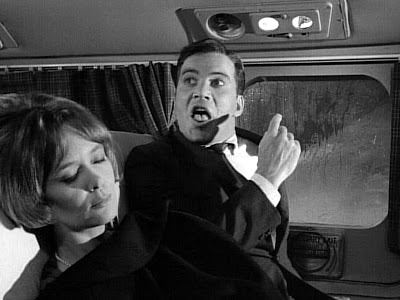
The OA: A Near Story Experience
Spoiler alert. If you haven’t yet watched Netflix’s series, The OA, to the end yet, go away and come back after you have. It’s okay. We’ll wait.

Okay.
The OA is the story of Prairie Johnson, adopted daughter of two small town Samaritans who has just turned up in the hospital and on YouTube after having been abducted seven years previous, just as she reached her maturity. As she tries to readjust to normality, she acts weird and assembles her own little quasi cult of followers who meet every night in a half-finished house to hear the spooky tale of her childhood, her abductor’s maniacal research into near death experiences, and the trans-dimentional Tai-Chi she brought back from the wichy woman at the bottom of the lake, the veracity of which is apparently demonstrated by the odd nocturnal nosebleed.
Got that? Doesn’t matter. No really,
it doesn’t matter. See, however much Brit Marling and Zal Batmanglij have accomplished with this polished, moving tale, they’ve forgotten the cardinal rule of storytelling: it has to matter. There’s a reason dramas are sold as being based on a true story even when the only thing true is that most of the participants had a heartbeat. No one wants to slip into story world, live and struggle with a protagonist, and then be told “oh, never mind, it was all just a dream. We were in Purgatory. We thought we were battling evil, but it turns out we just had Curry for dinner and we’re ghosts or replicants or fembots. And anyway, look at that, the narrator’s mad as a hatter.
Remember the old Twilight Zone episode where William Shatner sees a monster on the wing of the airplane, only nobody else can see it, and at the end of the episode you never really know if there was a monster chewing on the wing or if the gilded powerlessness of modernity just shorted out one synapse too many? 
No? Okay, go watch it. It’s a classic.
But here’s the thing. That sort of ambiguity works in short fiction. It doesn’t work in longer works–like when I’ve invested nine or ten hours in getting to know Prairie and all the good folks of Mayberry on Meth who she’s impacted and drawn into her little world.
I liked that part. I’m not a big fan of woo, but I’d have been happy to watch this gang open a portal and go off into the ether to confront Mr. Bad. I’m not okay with learning, at the last minute, that somewhere along the way, Prairie came up to straws short of an Easter Bunny and literally nothing in the entire story happened.
Actually, I’d even have been okay with that. As a writer, I can think of several endings that would have been deeply satisfying.
- It’s eventually made clear that Praire is insane. We see her getting the institutional help she needs with the support of her adopted dad. Her newly re-disillusioned cohort breaks up, turns each to the next chapter in life, and each realizes the growth they have experienced together, and recalls their tumultuous acquaintance with gratitude.
- It’s never made clear that Prairie is insane, but when the gunman appears on school grounds and teacher Betty sees the administration fleeing, she mans up, enters the cafeteria, and talks the gunman down with a heart-rending speech that probably leaves her bleeding out, but leaves the viewers knowing that even if she dies, she’s recovered the self respect worn away by years of bureaucratic toil.
- We are led to wonder whether Perry is insane but at the moment the gunman enters the cafeteria, the five protagonists all look at each other, leap out and start doing their crazy dance, time slows to a standstill, and one of them cracks the gunman over the head with a chair. Prairie may be crazy, but she’s also right, and in season to, she will journey with the new A-team to save Homer and rip Mr. Bad a new one.
- Prairie is shown to be insane, but when the gunman enters the cafeteria, the members of her cohort exchange glances, each grab something hard, and together, rise and beat the living hell out of the gunman, thus showing that even though insanity brought them together, they have strength together.
- From the very beginning, hints are dropped that Prairie might be insane (or more correctly, her cohort picks up on the hints all around them) but the story becomes not about the woo, but about the cohort. After a few days, they all know she’s nuts, but they keep coming because each is convinced that doing so will help her, or help one of the others, or help themselves (provide family) and in the end, all these things are true.
What was really disappointing is that, where the ending could have been about the growth of all the characters, instead it was about they pathetic lives and gullibility, which led them to hop up and quack like chickens in front of an armed mad man, and only manage to get Prairie killed instead of themselves, which was meant to be tragic but actually was kind of fortuitous.
Some people don’t have any trouble with ambiguous endings. I get that. My problem is that I think it’s kind of chicken shit on the part of the author. It implies that the author either was unable or unwilling to do the work of choosing one course and sticking with it. I realize not everybody feels that way. There is certainly an argument to be made that the ambiguous ending draws the reader or viewer in to the story more deeply and permits–perhaps requires them to take an active role in deciding which parts of the story are real and which are not. I get that, and I don’t have a problem with that.
The problem I have with the OA is that the reader has too much invested in the story to be left dangling in the breeze. It’s authorial manipulation, and is very unsatisfying.
Kudos to Netflix for embracing the idea of television based on, you know, story.
The OA is that, and had real literary potential–right up until it flushed it all away.


Lololol my dude your forgetting some serious stuff here. She was blind and cured. Happ is real. Think about it, season 1. I mean come on. Of course the world will call her crazy but she’s not. Just wait.